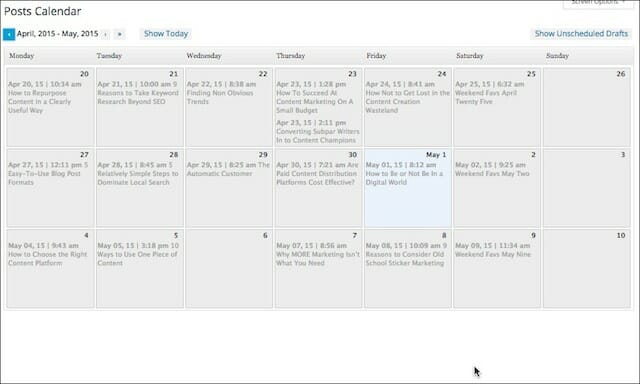I talk about content, well, all of the time. I know many of you are sick of reading about it, but I don’t think it’s going away anytime soon. In fact, high-quality content that addresses the needs, concerns and questions of your ideal clients is pretty much the price of admission these days.
It’s not enough to create and optimize web pages and call that content either. You must commit to producing content much like a publisher of a magazine and you must do it strategically.
Content is Strategy
Waking up on Monday and deciding what to write about on your blog is not a content strategy. Content is such an essential element in the marketing puzzle you must plan your content like you might your promotional calendar or budget for the year.
Taking a strategic view of content means you must understand the body of work you need to create over time to turn your content efforts into an asset that will serve your business long-term.
In my view, this means applying the same kind of keyword, competitive and linking research that most associate with SEO to your editorial approach. And that’s the point really – in order for your content to pay dividends it must help drive traffic, shares, influence and conversion.
Finding Your Themes
The first step is to start making a list of your most important themes. I generally try to find three core themes and about nine supplemental themes. (Nice tidy 12 monthly themes.) Your core themes are the kinds of things that might be found on your homepage or even in the title attribute of your home page. Or, perhaps the main navigational elements of your site.
Your supplemental themes round out the list and while not as important, certainly make fodder for your ongoing blogging efforts.
Start with brainstorming. Lock yourself away and start thinking about the kinds of things people ask about the most, where you make your most money, or where you see the greatest opportunities in your industry. This is often enough to create a good start to your list. Obviously, if you have a team, get them involved – they may actually know better than you. (Industry jargon that means nothing to the prospect must be left out here.)
Now take that list to the Google Keyword Planner and see if you can find themes that have significant volume. You must balance key terms with being too generic though. A term like “marketing” wouldn’t make sense as a theme, even for a marketing consultant, but a term like “referral marketing tactics” might.
From this work, you should have developed a pretty solid dozen or so candidates for your monthly themes. I also like to take the terms to the Google search page and see what they suggest as related searches and who shows up on page one for these terms now.
Researching Topics
Now that I have my terms I want to get more specific ideas for actual topics I might map to each month.
For this task, I lean pretty heavily on a tool called BuzzSumo. There are other tools that can be useful, such as Topsy, but BuzzSumo does so many things I find myself sticking to it.
The basic thing BuzzSumo does is show you the most shared content for any term you put into its search box. (Note this can be a URL as well if, for example, you want to see most shared content on a competitors site.)
I use it to uncover actual highly shared blog posts around each of my themes so I can get some solid ideas for my own content and see what types of things get shared the most by others. You do have to use a little creativity here – for example a plumber that does bathroom plumbing might also search some common problems related to bathroom plumbing to find good ideas.
I might also employ a site like Quora to see the kinds of questions people are asking about my themes. Answering questions is always a good idea for a blog post.
Going Beyond
Now that I have a good start to the actual topics related to my themes, I want to start figuring out who else writes about my themes, who else like to share this kind of content and what sites are seen as influential in the space.
Again, BuzzSumo is a pretty great power tool. With the higher paid plans, you can discover a list of influential bloggers related to the topics you are interested in. I generally follow and list these folks on Twitter and even subscribe to some of their blogs in Feedly so I can start sharing their content. Eventually, I may try to develop the kind of relationship where I could ask one or more of these folks if I could submit guest content or if they would like to do so for my site.
You can also narrow your topic search to include only guest posts. It’s pretty good bet that a person likes to write guest posts or a site likes to take guest posts if they show up on this search.
This is indeed a way to get more content to fill your plan but it’s also the strategic part of building links to your site and gaining exposure for your content outside of your own efforts.
I further use BuzzSumo’s info to show me who is linking to and sharing content related to my topics and often create more lists to look for more strategic relationships beyond what people might call the “usual suspects in thought leadership land.”
Now Document
By this point, I have a pretty good amount of content identified to fill in my plan so it’s time to turn to a tool to document a plan and calendar. You can use any spreadsheet really (Smartsheet, Google Sheets, Excel) to document your themes across twelve months and then simply add the elements of your platform – blog, podcast, guest posts, eBooks, etc. Then you set your goals for how much content you want in each element each month. (I wrote a post a while back called 10 Ways to Use One Piece of Content – you should read this post as well if today’s idea appeals to you.)
For a specific view of each month, you might want to add an editorial calendar as a spreadsheet or by using a WordPress plugin. It’s pretty amazing how simply documenting a plan seems to help get more done by keeping the focus on the future rather than scrambling to create the present. (I realize that’s not a very Zen idea, but it’s the reality of business.)
You know you need content, so stop fighting it and start making a plan that allows you to better delegate, build and amplify your content asset.



